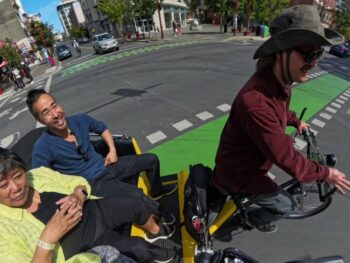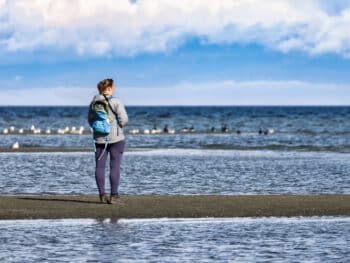As B.C.’s tourism industry prepares to once again welcome visitors from around the globe, representatives from across the sector gather next week to share innovative ideas, tackle challenges and celebrate successes.
The 2022 BC Tourism & Hospitality Conference, a partnership between the Tourism Industry Association of BC and the BC Hotel Association, is at the Richmond Conference Centre March 9 to 11.
Exploring both shared opportunities and shared challenges, year’s conference theme, “Kickstarting the Comeback,” highlights an industry that’s ready for the return to travel.
In the 12 months since last year’s virtual conference, TIABC and BCHA have been busy behind the scenes, working with governments and industry stakeholders at all levels to prepare for the return of both recreational and corporate visitors.
As borders open and travel becomes easier, “it’s given us the confidence and hope that the last of the restrictions are behind us and we can rebuild the industry and look to recovery as a whole,” says Walt Judas, CEO of Tourism Industry Association of BC.
While a keen response is expected from travellers who’ve been waiting to visit, the industry is still navigating challenges such as significant staff shortages and remaining restrictions. Ongoing support and direction from both provincial and federal governments is needed, as is co-ordinated travel messaging, Judas says.
That co-ordinated approach has been a key take-away from the last two years.
“One of the things we’ve learned during the pandemic that’s going to serve us so well during the recovery is the importance of partnerships,” reflects Ingrid Jarrett, President and CEO of the BC Hotel Association.
Whether it’s re-establishing B.C.’s position on the international stage or working with communities to address accommodations shortages for both hospitality staff and residents, “we have the opportunity to come together for a solution,” Jarrett says.
The spirit of cooperation is evident in many of the conference topics, from integrated transportation to a session exploring the Sí:yá:ya Yóyes Friends Working (Together) Plan, tailored to guide Tourism Ch’illiwack in providing tangible contributions to the reconciliation process with Indigenous peoples.
Other themes include reconciliation work with Indigenous communities, and sustainability – recognizing the impact tourism can have on a region, both positive and negative, and considering the “5 Ps: People, Planet, Prosperity, Partnerships and Peace,” Jarrett says.
Boosting business travel and the conference and events sector will be critical to making B.C. a top-of-mind destination again, as the industry works to re-schedule the many postponed events and attract new ones.
Judas would also like to see a sunset clause for the requirement that fully vaccinated travellers require a rapid antigen test before entering Canada, especially with the cruise ship industry poised to return.
No. 1 tourism recovery challenge: Staff
While easing restrictions will make it easier for visitors to travel to and around B.C., the industry faces another major hurdle: staffing. As the No. 1 priority for B.C’s tourism operators, innovative ideas to address the workforce crisis will be a key theme throughout the conference.
“We are desperately short of labour,” Judas says, noting that tourism employed 350,000 people in British Columbia pre-pandemic. That dropped to 171,000 at the height of COVID closures, and while employment has climbed back to about 300,000, they’re still tens of thousands of people short.
“How do you operate a hotel with half the people you used to have?” Jarrett asks.
Jarrett, Judas and others are working on various initiatives to get more workers where the industry needs them.
In conjunction with Go2HR, human resource and health & safety specialists for B.C.’s tourism and hospitality sector, research is looking at the impediments to employment, such as competing industries, limited housing and high cost of living, and identifying specific regions or sectors most impacted by staffing shortages.
“Gaining that good understanding lets you look at ways to address the issue,” Judas says.
Potential steps couldinclude streamlining the entry process for temporary foreign workers – like skilled river rafting guides who travel to B.C. in the spring, following the Argentina rafting season – especially for those who have lived and worked here before, Judas says.
Extensions to wage subsidy programs are also required during the recovery phase, and must include sole operators and seasonal operations that have been left out of previous programs, he adds. Individual businesses can also take steps to improve staff retention, such as employee training, benefits, and opportunities for growth – discussions also covered in several conference sessions.
Tourism as a career, not only a job
Attracting people to the tourism sector also requires showcasing its longterm career opportunities, an in reaching out to traditionally under-represented people, including women, Indigenous communities, new Canadians and people with disabilities, Judas says.
“I don’t think people realize the scope when we’re talking about tourism and hospitality – there are accountants, lawyers, doctors, landscaping professionals, skilled trades and many others. There are also jobs that are flexible seasonal and casual.”
And then there’s the opportunity to connect with people from around the world, and be part of their British Columbia experience. “You’re creating memories for people,” he says.
Learn more about the 2022 BC Tourism & Hospitality Conference at bctourismandhospitalityconference.com
***
Plan your adventures throughout the West Coast at westcoasttraveller.com and follow us on Facebook and Instagram @thewestcoasttraveller. And for the top West Coast Travel stories of the week delivered right to your inbox, sign up for our weekly Armchair Traveller newsletter!











 Cariboo Chilcotin Coast, Gold Rush Trail among top 50 most-loved Canadian tourism destinations
Cariboo Chilcotin Coast, Gold Rush Trail among top 50 most-loved Canadian tourism destinations